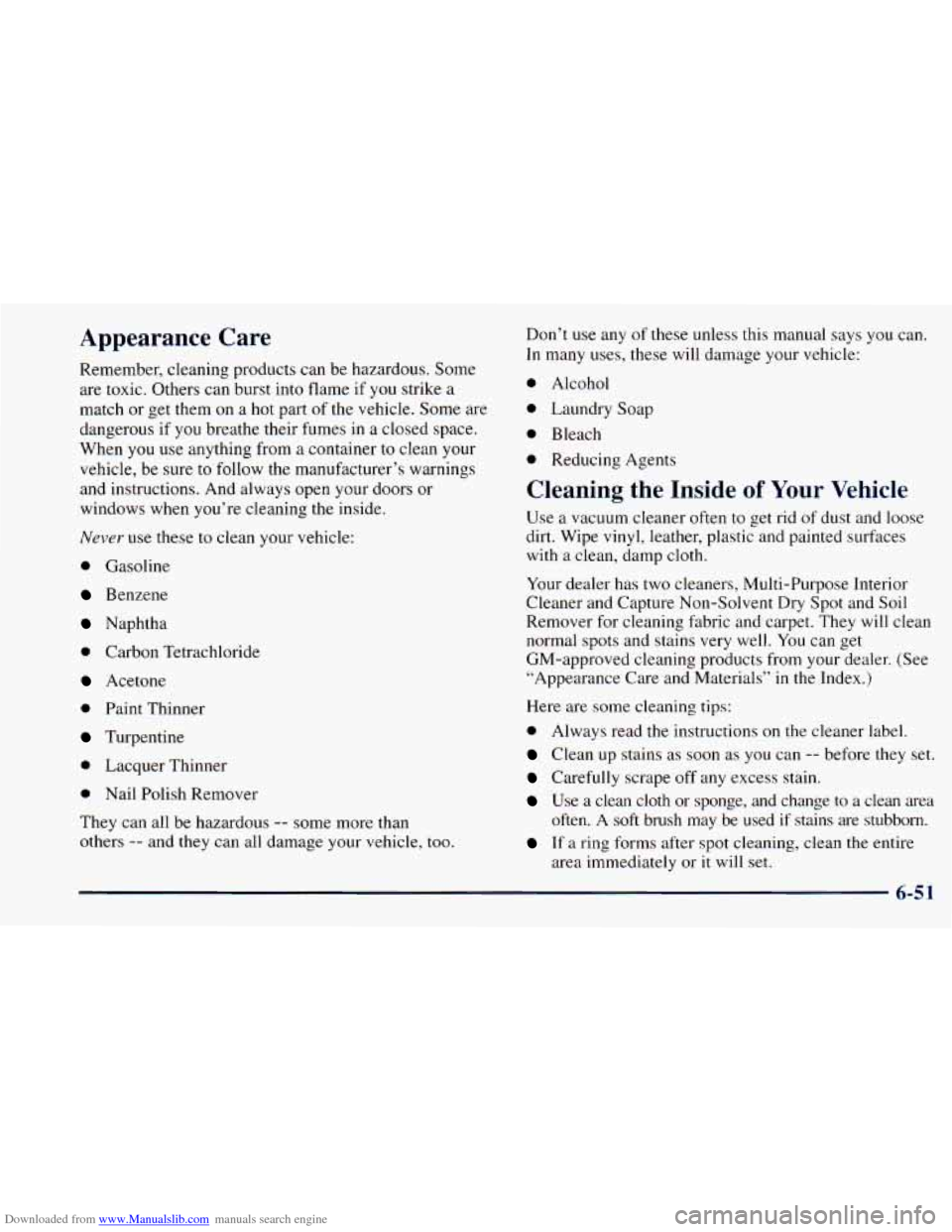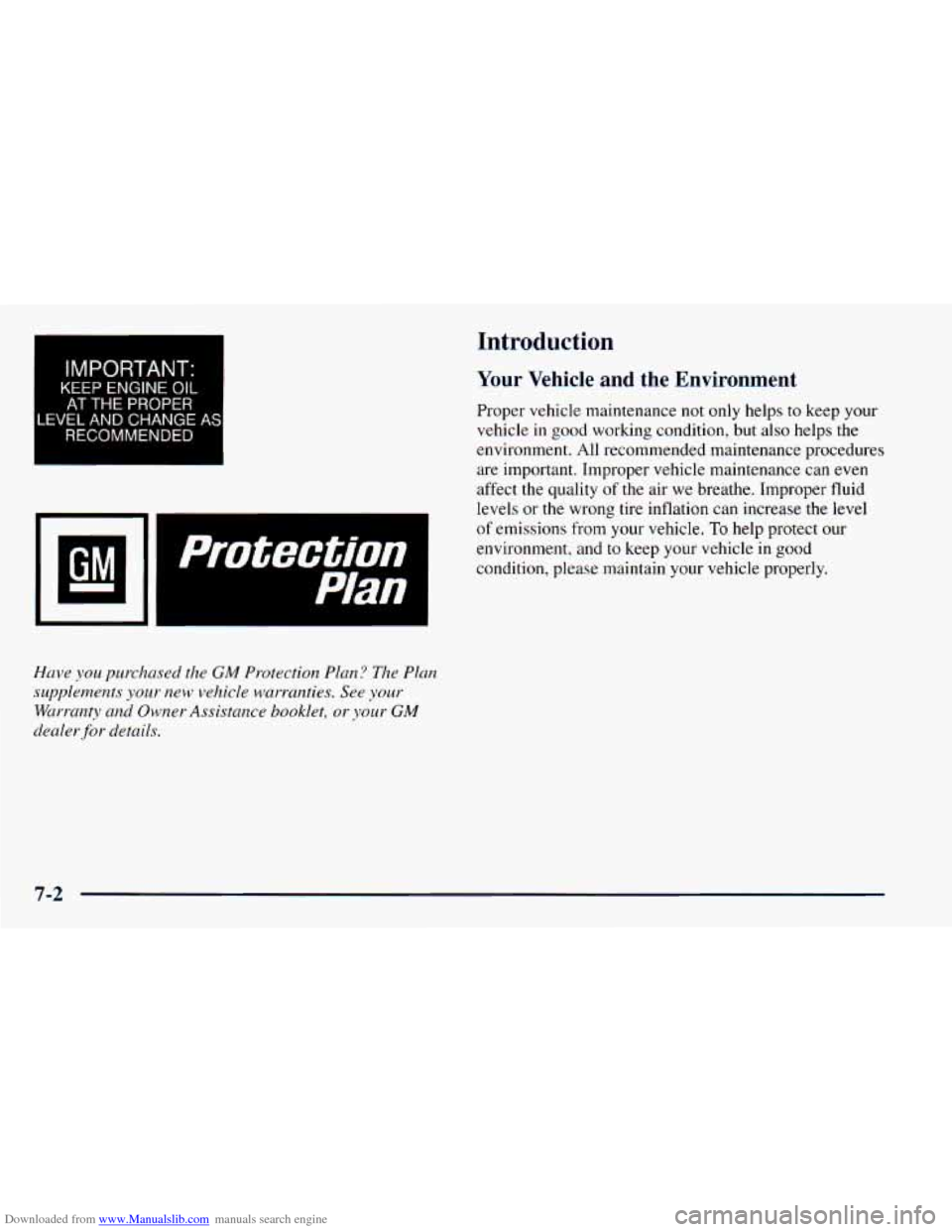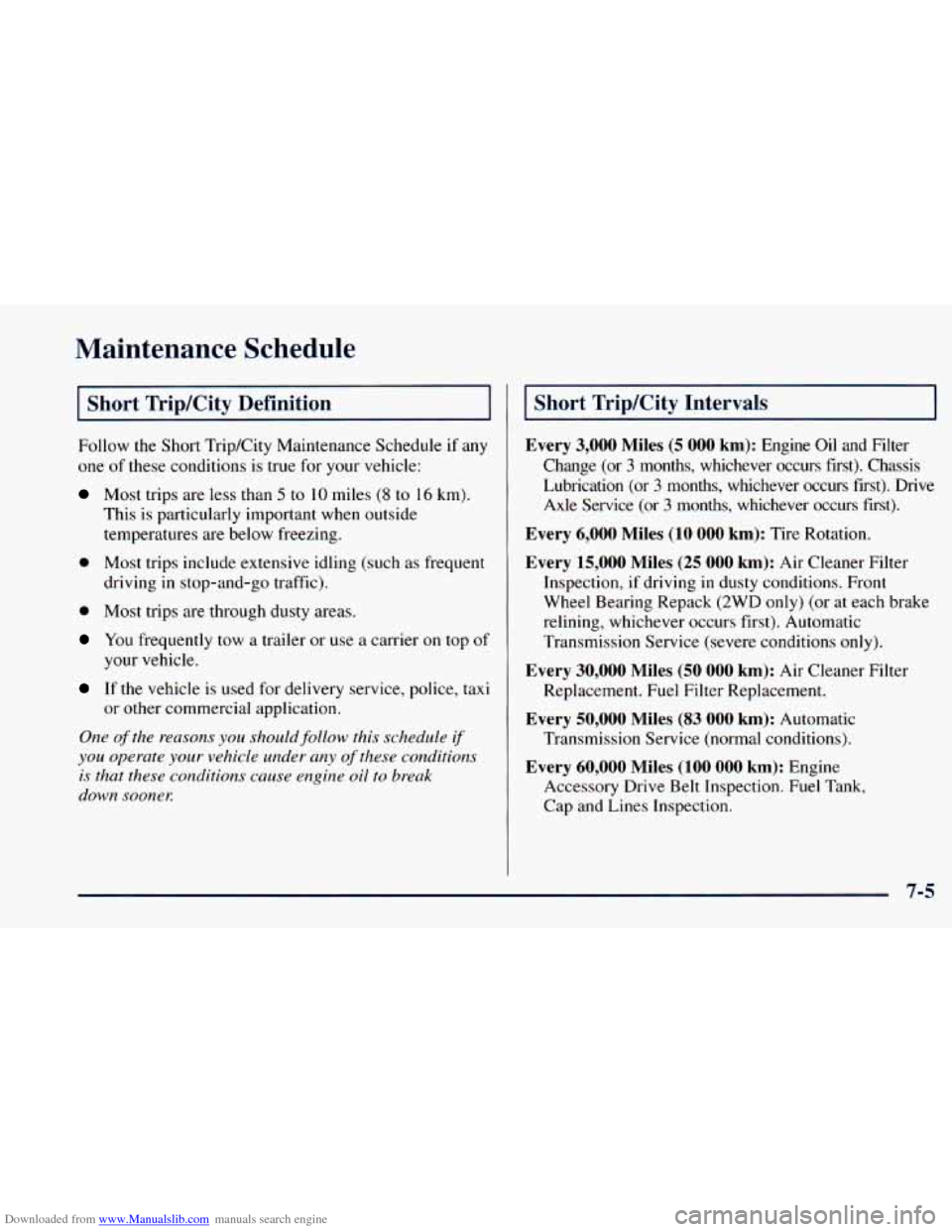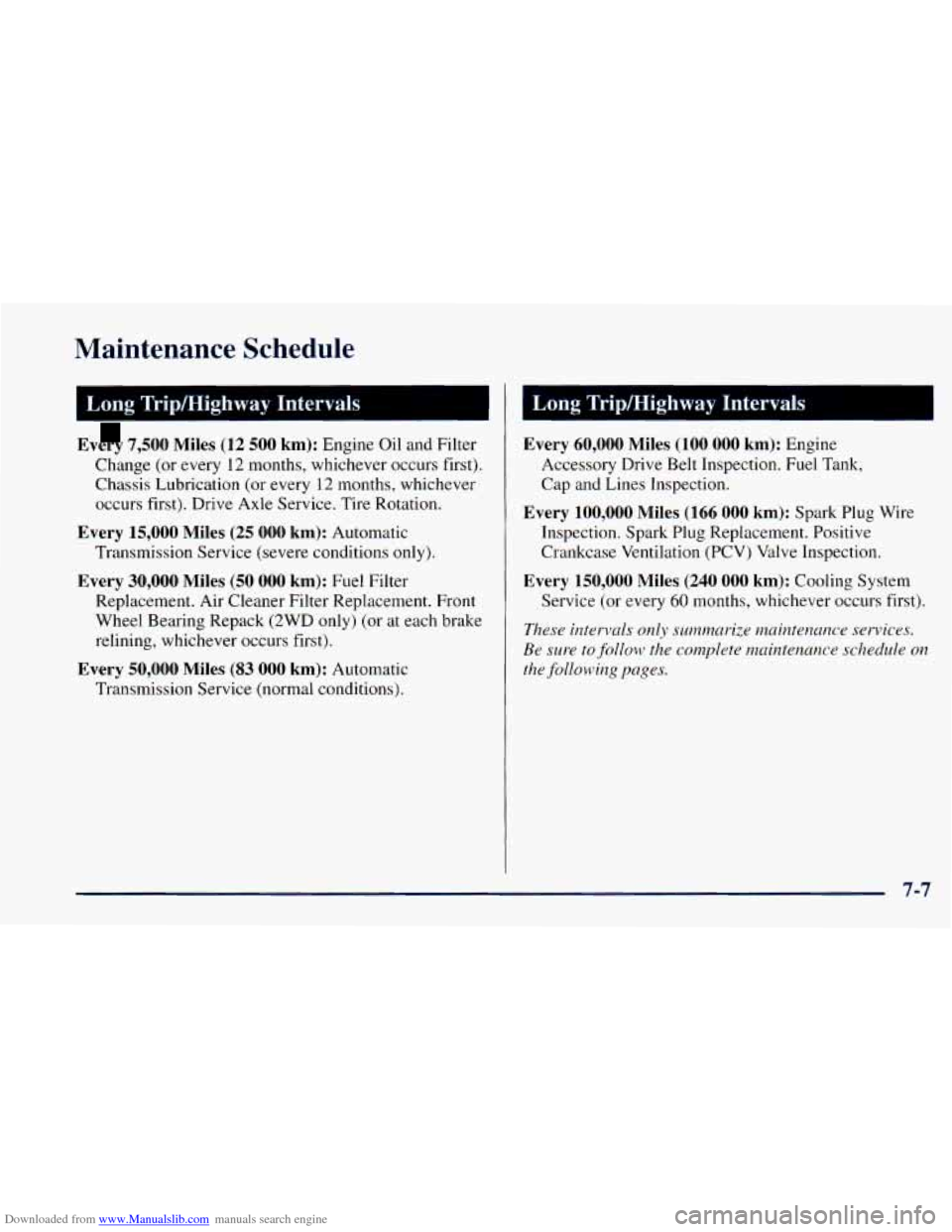1998 CHEVROLET ASTRO oil change
[x] Cancel search: oil changePage 313 of 414

Downloaded from www.Manualslib.com manuals search engine Appearance Care
Remember, cleaning products can be hazardous. Some
are toxic. Others can burst into flame if
you strike a
match or get them on a hot part
of the vehicle. Some are
dangerous if you breathe their fumes in
a closed space.
When you use anything from a container to clean your
vehicle, be sure to follow the manufacturer’s warnings
and instructions. And always open your doors or
windows when you’re cleaning the inside.
Never use these to clean your vehicle:
0 Gasoline
Benzene
Naphtha
0 Carbon Tetrachloride
Acetone
0 Paint Thinner
Turpentine
0 Lacquer Thinner
0 Nail Polish Remover
They can all be hazardous
-- some more than
others
-- and they can all damage your vehicle, too. Don’t
use any of these
unless this manual says you can.
In many uses, these will damage your vehicle:
0 Alcohol
0 Laundry Soap
0 Bleach
0 Reducing Agents
Cleaning the Inside of Your Vehicle
Use a vacuum cleaner often to get rid of dust and loose
dirt. Wipe vinyl, leather, plastic and painted surfaces
with a clean, damp cloth.
Your dealer has two cleaners, Multi-Purpose Interior
Cleaner and Capture Non-Solvent Dry Spot and Soil
Remover for cleaning fabric and carpet. They will clean
normal spots and stains very well. You can get
GM-approved cleaning products from your dealer. (See
“Appearance Care and Materials”
in the Index.)
Here are some cleaning tips:
0 Always read the instructions on the cleaner label.
Clean up stains as soon as you can -- before they set.
Carefully scrape off any excess stain.
Use a clean cloth or sponge, and change to a clean area
If a ring forms after spot cleaning, clean the entire
often.
A soft brush may be used if stains are stubborn.
area immediately or
it will set.
Page 331 of 414

Downloaded from www.Manualslib.com manuals search engine Normal Maintenance
Replacement Parts
Replacement part numbers listed in this section are
based on the latest information available
at the time of
printing, and are subject to change. If a part listed in this
manual is not the same as
the part used in your vehicle
when
it was built, or if you have any questions, please
contact your GM truck dealer.
Engine Oil Filter
................ AC Type PF52
Air Cleaner
................. AC Type A1 163C
Positive Crankcase
Ventilation (PCV) Valve
....... AC Type CV746C
Spark Plugs
................... AC Type 4 1-932
Spark Plug Gap
.......... 0.060 inches ( 1.52 mm)
Fuel Filter
..................... AC Type GF481
Thermostat
............... GM Part No. 12551472
Wiper Blades (Front)
, , . . , Trico 22110158, Pin Type
18 inches (45.7 cm) Length
. Trico 22 154396, Pin Type
14 inches (35.5 cm) Length
Wiper
Blade (Rear)
, ,
Vehicle Dimensions*
Length ............. , . 189.8 inches (482 cm)
Width
................. 77.5 inches (196.8 cm)
Height
................... 76.0 inches (193.0 cm)
Wheelbase
.............. 1 11 .O inches (28 1.9 cm)
Front Tread Width
....... 65.1 inches ( 165.4 cm)
Rear Tread Width
.......... 65.1 inches (165.4 cm)
*Figures reflect base equipment only.
6-69
Page 336 of 414

Downloaded from www.Manualslib.com manuals search engine Introduction
IMPORTANT-
KEEP ENGINE OIL
AT THE PROPER
LEVEL AND CHANGE A$
RECOMMENDED
Plan
Have you purchased the GM Protection Plan? The Plan
supplements
your new vehicle warranties. See your
Warranty and Owner Assistance booklet, or your GM
dealer for details.
Your Vehicle and the Environment
Proper vehicle maintenance not only helps to keep your
vehicle in good working condition, but also helps the
environment. All recommended maintenance procedures
are important. Improper vehicle maintenance can even
affect the quality
of the air we breathe. Improper fluid
levels
or the wrong tire inflation can increase the level
of emissions from your vehicle. To help protect our
environment, and to keep your vehicle in good
condition, please maintain your vehicle properly.
7-2
Page 339 of 414

Downloaded from www.Manualslib.com manuals search engine Maintenance Schedule
I Short Trip/City Definition
Follow the Short Trip/City Maintenance Schedule if any
one of these conditions
is true for your vehicle:
Most trips are less than 5 to 10 miles (8 to 16 km).
This is particularly important when outside
temperatures are below freezing.
driving
in stop-and-go traffic).
0 Most trips are through dusty areas.
You frequently tow a trailer or use a carrier on top of
If the vehicle is used for delivery service, police, taxi
One of the reasons you should follow this schedule if
you operate your vehicle under any of these conditions
is that these conditions cause engine oil to
break
down sooneE
0 Most trips include extensive idling (such as frequent
your vehicle.
or other commercial application.
I Short Trip/City Intervals
Every 3,000 Miles (5 000 km): Engine Oil and Filter
Change (or
3 months, whichever occurs first). Chassis
Lubrication (or
3 months, whichever occurs first). Drive
Axle Service (or
3 months, whichever occurs first).
Every 6,000 Miles (10 000 km): Tire Rotation.
Every 15,000 Miles (25 000 km): Air Cleaner Filter
Inspection, if driving
in dusty conditions. Front
Wheel Bearing Repack
(2WD only) (or at each brake
relining, whichever occurs first). Automatic
Transmission Service (severe conditions only).
Every 30,000 Miles (50 000 km): Air Cleaner Filter
Replacement. Fuel Filter Replacement.
Every 50,000 Miles (83 000 km): Automatic
Transmission Service (normal conditions).
Every 60,000 Miles (100 000 km): Engine
Accessory Drive Belt Inspection. Fuel Tank,
Cap and Lines Inspection.
7-5
Page 341 of 414

Downloaded from www.Manualslib.com manuals search engine Maintenance Schedule
L Long Tripmighway Intervals I
Every 7,500 Miles (12 500 km): Engine Oil and Filter
Change (or every 12 months, whichever occurs first).
Chassis Lubrication
(or every 12 months, whichever
occurs first). Drive Axle Service. Tire Rotation.
Every 15,000 Miles (25 000 km): Automatic
Every 30,000 Miles (50 000 km): Fuel Filter
Transmission Service (severe conditions
only).
Replacement.
Air Cleaner Filter Replacement. Front
Wheel Bearing Repack
(2WD only) (or at each brake
relining, whichever occurs first).
Every 50,000 Miles (83 000 km): Automatic
Transmission Service (normal conditions).
Long Tripmighway Intervals
Every 60,000 Miles (100 000 km): Engine
Accessory Drive Belt Inspection.
Fuel Tank,
Cap and Lines Inspection.
Inspection. Spark Plug Replacement. Positive
Crankcase Ventilation (PCV) Valve Inspection.
Every 150,000 Miles (240 000 km): Cooling System
Service (or every
60 months, whichever occurs first).
These intervals only summarize maintenance services.
Be sure to follow the complete maintenance schedule on
the following pages.
Every 100,000 Miles (166 000 km): Spark Plug Wire
7-7
Page 342 of 414

Downloaded from www.Manualslib.com manuals search engine Short TripKity Maintenance Schedule
The services shown in this schedule up to 100,000 miles
(166 000 km) should be performed after 100,000 miles
(166 000 km) at the same intervals. The services shown
at 150,000 miles
(240 000 km) should be performed at
the same interval after 150,000 miles (240 000 km).
See “Owner Checks and Services’’ and “Periodic
Maintenance Inspections” following.
Footnotes
The U.S. Envlronmental Protection Agency or the
California Air Resources Board has determined that the
failure to perform this maintenance item will
not nullify
the emission warranty or limit recall liability prior to the
completion
of the vehicle’s useful life. We, however,
urge that all recommended maintenance services be
performed at the indicated intervals and the maintenance
be recorded.
# Lubricate the front suspension, ball joints and kingpin
bushings, steering linkage and transfer case shift linkage,
parking brake cable guides, and brake pedal springs.
+ A good time to check your brakes is during tire
rotation. See “Brake System Inspection” under “Periodic
Maintenance Inspections” in Part
C of this schedule.
** Drive axle service (see “Recommended Fluids and
Lubricants”
in the Index for proper lubricant to use):
0
0
0
Locking Differential -- Drain fluid and refill at first
engine oil change. At subsequent oil changes, check
fluid level and add fluid as needed. If driving
in
dusty areas or towing a trailer, drain fluid and refill
every 15,000 miles
(25 000 km).
Standard Differential
-- Check fluid level and add
fluid as needed at every oil change. If driving in
dusty areas or towing a trailer, drain fluid and refill
every 15,000 miles
(25 000 km).
More frequent lubrication may be required for
heavy-duty use.
7-8
Page 343 of 414

Downloaded from www.Manualslib.com manuals search engine I Short Trip/City Maintenance Schedule I
3,000 Miles (5 000 km)
0 Change engine oil and filter (or every 3 months, whichever occurs first).
0 Lubricate chassis components (or every 3 months, whichever occurs first).
0 Check readfront axle fluid level and add fluid as needed. Check constant
An Emission Control Service.
(See footnote #.)
velocity joints and axle seals for leaking. (See footnote **.)
6,000 Miles (10 000 km)
0 Change engine oil and filter (or every 3 months, whichever occurs first).
0 Lubricate chassis components (or every 3 months, whichever occurs first).
Check readfront axle fluid level and add fluid as needed. Check constant
0 Rotate tires. See “Tire Inspection and Rotation” in the Index for proper
An Emission Control Service.
(See footnote #.)
velocity joints and axle seals for leaking. (See footnote **.)
rotation pattern and additional information. (See footnote +.)
9,000 Miles (15 000 km)
0 Change engine oil and filter (or every 3 months, whichever occurs first).
An Emission Control Service.
1 DATE I
MILEAGE
DATE
I
DATE MILEAGE
ACTUAL SERVICED BY:
(Continued) I I
7-9
Page 344 of 414

Downloaded from www.Manualslib.com manuals search engine I Short TripKity Maintenance Schedule I
9,000 Miles (15 000 km) (Continued)
0 Lubricate chassis components (or every 3 months, whichever occurs rlrst).
0 Check readfront axle fluid level and add fluid as needed. Check constant
(See
footnote
#.)
velocity joints and axle seals for leaking. (See footnote *:I:.)
12,000 Miles (20 000 km)
0 Change engine oil and filter (or every 3 months, whichever occurs first).
An Emission Control Service.
0 Lubricate chassis components (or every 3 months, whichever occurs first).
(See footnote
#.)
0 Check readfront axle fluid level and add fluid as needed. Check constant
Rotate tires. See “Tire Inspection and Rotation” in the Index for proper
velocity
joints and axle seals for leaking. (See footnote
**.)
rotation pattern and additional information. (See footnote +.)
15,000 Miles (25 000 km)
0, Change engine oil and filter (or every 3 months, whichever occurs first).
0, Lubricate chassis components (or every 3 months, whichever occurs first).
An Emission Control Service,
(See footnote #.)
DATE 1
MILEAGE
I DATE I
I MILEAGE ACTUAL I SERVICEDBX I
7-10